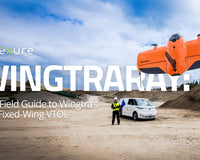Imagine a farm's broad, sweeping fields as a vast canvas, where each brush stroke represents a decision that shapes the yield and health of the crops. Just as an artist steps back to view the whole canvas, modern farmers are now elevating their perspective—literally—through the use of Unmanned Aircraft Systems (UAS), or drones, to oversee and optimize these living canvases.
In agriculture, drones are not merely flying cameras; they are increasingly essential tools that transform how farmers manage vast tracts of land efficiently and sustainably. From providing a bird’s-eye view of crop health to delivering precise data that drives smarter farming decisions, the benefits of UAS in agriculture are profound.
In this article, we'll explore the evolving role of drones in agriculture and dive into how they enhance decision-making and operational efficiencies. We'll look at technological advancements that empower UAS in farm management, illustrate these points with real-world applications, and how you can get started integrating drone tech to your farm management.

What is Precision Agriculture?
Before we discuss the intersection of drone technology in farming, it’s helpful to understand precision agriculture, its methodology, and how it differs from traditional farming.
Precision agriculture represents a transformative shift in farming practices, distinguished by its use of advanced technologies to enhance resource efficiency and productivity. This approach leverages real-time data and spatial analysis to tailor farming actions to the specific needs of each segment within a field, optimizing inputs such as water, fertilizer, and pesticides to increase crop yields and reduce environmental impact.
Evolution and Capabilities of Drones in Agriculture
In the past, drones only augmented traditional methods by providing detailed aerial imagery that helped map field variability and monitor crop health.
Today, uncrewed aerial vehicles (UAVs) are equipped with sophisticated multispectral sensors and imaging technologies capable of efficiently capturing high-resolution data across large swathes of land. This allows for detailed analysis of soil health, plant disease, and moisture levels without traditional labor-intensive field surveys.
Optimizing Farm Outputs with Drone Technology
Drones like the DJI Mavic 3 Multispectral have revolutionized data gathering. With advanced multispectral sensors, these drones can assess plant health across vast fields by capturing light absorption and reflectance data in different spectra.
When paired with software such as Solvi for row crops or Aerobotics for perennial crops, farmers can interpret this aerial data to make informed decisions. For instance, by identifying variations in crop health, farmers can apply water, fertilizers, and pesticides more selectively, leading to reduced costs and improved yields.
Optimizing Farm Outputs with Drone Technology
Integration of AI and Machine Learning
One of the more significant recent advancements in drone technology is the integration of Artificial Intelligence (AI) and Machine Learning (ML). These technologies enhance drone autonomy, enabling sophisticated operations such as real-time data processing and advanced imaging analysis. AI-driven drones can interpret environmental data, allowing them to make independent decisions about crop spraying, irrigation, and health monitoring.
Enhanced Connectivity and IoT Integration
Incorporating the Internet of Things (IoT) into drone systems is revolutionizing how these devices operate within agricultural settings. By connecting drones to a broader network of sensors and data points across the farm, they can collect and transmit real-time information on soil conditions, crop health, and weather patterns. This connectivity is pivotal for remote monitoring and management, enabling drones to perform tasks like precision irrigation based on real-time field data.
Advancements in Battery Technology and Flight Efficiency
Improvements in battery technology are extending drones' endurance, allowing for longer flight times and greater range. This advancement is crucial for large-scale farms, where the ability to cover vast areas without frequent recharging is critical.
Sophisticated Sensor Technology and Imaging
Drones equipped with high-resolution multispectral images provide detailed insights into crop health, soil quality, and pest infestation. These detailed imaging capabilities enable farmers to implement precision farming practices more effectively, applying resources only where needed, reducing waste and increasing the efficiency of their operations.
Real-World Applications
Precision Crop Monitoring and Management:
A multispectral imaging study by drones on a wheat farm identified suboptimal growth areas due to hidden nutrient deficiencies. By adjusting fertilization based on the drone data, the farm saw an increase in yield compared to previous seasons where traditional monitoring methods were used.
Enhanced Vineyard Management:
In a California vineyard, drones equipped with NDVI sensors assessed vine health and vigor. The precise data allowed for targeted care and resource allocation. As a result, the vineyard saw improved grape quality and increased overall yield due to better disease management and optimized irrigation practices.
Efficiency in Water Usage in Avocado Orchards::
Through thermal imaging and NDVI analysis, an avocado orchard was able to optimize its irrigation schedules and reduce water usage while maintaining, and in some areas improving, fruit yield and quality. This was particularly crucial during a drought, helping the orchard maintain sustainability and profitability.

Getting Started with UAS for Farm Management
1. Understand the Basics
Before exploring drone technology, it's important to understand what drones can do for agriculture. Drones aid in tasks like monitoring plant health, managing livestock, and assessing crop production through various imaging technologies, such as RGB, multispectral, and thermal imaging.
2. Choose the Right Drone
Before exploring drone technology, it's important to understand what drones can do for agriculture. Drones aid in tasks like monitoring plant health, managing livestock, and assessing crop production through various imaging technologies, such as RGB, multispectral, and thermal imaging.
3. Invest in Quality Sensors and Software
Enhance your drone's capabilities with appropriate sensors (thermal, multispectral) that can provide detailed data about crop health, soil conditions, and more. Software solutions can analyze this data to produce actionable insights, such as identifying areas that require more irrigation or fertilizer. Solutions such as Pix4DFields have been crucial for processing vast amounts of data to get a better understanding of what is taking place in a field, orchard, or research plots. Additionally, there are other software solutions that are more geared towards specific crop types, such as Aerobotics for perennial crops and Solvi for row crops. Both of these software solutions provide tree-to-tree and/or plant-to-plant analytics, providing granular data across orchards and fields.
4. FAA Certification and Regulations
In the U.S., any drone operation that contributes directly to business operations, such as farming, requires the operator to pass an FAA certification to obtain a remote pilot certification under Part 107. This certification ensures you understand the airspace regulations, risk management, and technical aspects of drone operation. Remember, the drone must also be registered with the FAA.
2. Practical Training and Continuous Learning
Practical experience is crucial. Start with smaller, manageable tasks to gain confidence. Utilize online resources, workshops, and training programs to keep up with new technologies and regulatory changes. Continuous learning will help you maximize the benefits of drone technology in agriculture.
If you're ready to explore how UAS technology can transform your
farming operations, contact Advexure's precision agriculture experts and UAS pilots. We can guide you on the best solutions tailored to your agricultural needs and help you integrate these technologies to enhance your farming efficiency and productivity. Contact Advexure today to start optimizing your farm for better yields.










